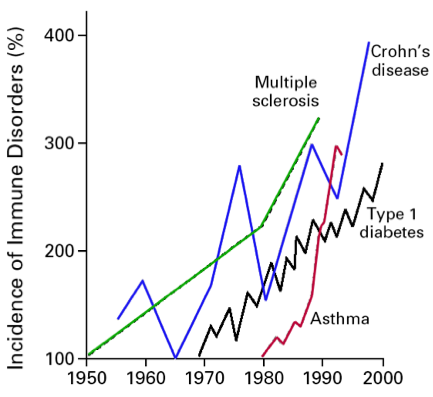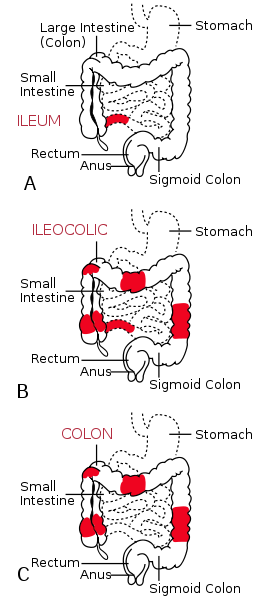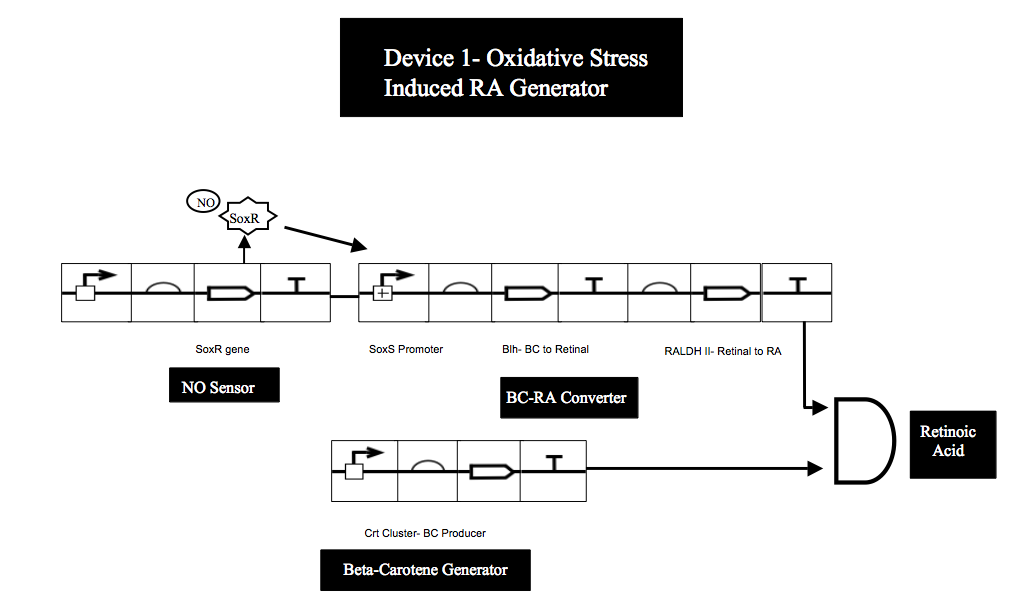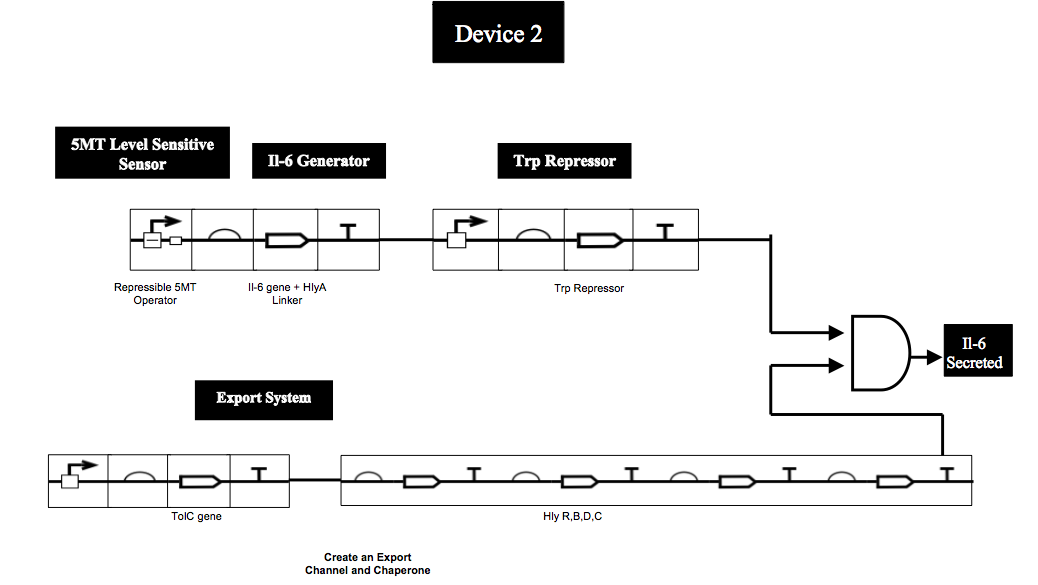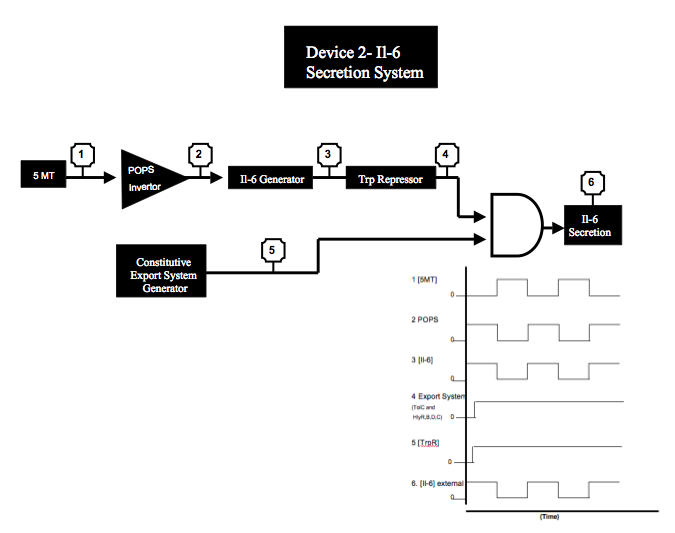Team:Stanford/ProjectPage
From 2009.igem.org
(→Device 1: Anti-Inflammatory Device) |
(→Results) |
||
| Line 73: | Line 73: | ||
==Results== | ==Results== | ||
| + | |||
| + | This summer, the team built three of the four device subparts, namely the SoxR/SoxS sensor, the retinoic acid generator and the 5-methyl tryptophan mutant trp sensor. All the sensors were built with GFP downstream of the sensor itself. As a result, only the sensing capability, that is the ability of sensor to recognize inflammation or immunosuppressive signal molecules, was tested. Of these three device subparts, the SoxR/SoxS sensor was characterized on both a high and low copy plasmid and found to be functional. Below are the graphs relating OD to time and GFP to time for the sensor on both the high and low copy vector strains: | ||
==Analysis== | ==Analysis== | ||
Revision as of 01:09, 22 October 2009

| Home | Project | Modeling | Parts | Notebook | Team | SBOL-V |
Contents |
Abstract
Inflammatory Bowel Disease is an autoimmune disease that results in inflammation of the colon and small intestine. IBD is a huge problem in developed countries, vastly growing with no effective therapy in sight. This disease is caused by an imbalance of immune T-cells, Th17 and T regulatory, which control inflammation and immunosuppression responses respectively. We propose a novel mechanism using synthetic biology that aims to regulate this balance in vivo. This involves a two-part device: one that regulates inflammation and the other immunosuppression. We cloned a device that recognizes superoxide producers, a byproduct of inflammation and Th17 proliferation, to produce retinoic acid, which blocks the further differentiation of Th17 cells. This device has been characterized, is well behaved and capable of recognizing superoxides, like paraquat, at optimum levels of 40 to 80 uM without growth inhibition. To control immunosuppression, we cloned and mutated the trp operon so that it recognizes 5-Methyl tryptophan, a target substrate of an enzyme involved in Treg immunosuppression, and designed a potential IL-6 excretion device to regulate Treg proliferation. The behavior of this novel tryptophan sensor has been studied by our group through the development of a mathematical model. Our results suggest that our construct has potential applications as a diagnostic or therapeutic tool for post-operative Crohn's patients
Background and Clinical Significance
Inflammatory Bowel Disease is a group of inflammatory diseases that affect the colon and small intestine. The disease comes in two varieties, either as Ulcerative Colitis (UC) or Crohn's Disease (CD). An autoimmune condition, IBD is becoming particularly prevalent in the industrialized nations of the world. Already, in the United States and Europe, the disease group affects over 4 million individuals. With a faster growth rate and higher incidence than other well known autoimmune diseases like multiple sclerosis and asthma, IBD will affect an even larger percentage of the world's population, particularly in industrializing nations like India and China, over the next thirty years. While both diseases, CD and UC, affect similar demographics, they tend to have very different symptoms that requires differential treatment methods. In Ulcerative Colitis the inflammation is usually continuous and can stretch from the colon to, in many cases, the rectum. The inflammation results in a continuous stretch of ulcers in these regions but very rarely in fistulas and abnormal passageways, a characteristic of Crohn's disease. Because of this shallow and continuous inflammation, Ulcerative Colitis can often be treated without remission by removing the affected areas of the colon or rectum.
Crohn's Disease
In contrast to Ulcerative Colitis, Crohn's Disease often includes the terminal ileum, the most distal part of the small intestine, and the colon. Unlike other forms of IBD, CD also results in patchy areas of inflammation with the localization of the disease "jumping" from distal portions of the small intestine to the colon. The localized bands of inflammation are often accentuated by the presence of fistula, granulomata and deep, transmural inflammation. As a result of the nature and localization of the inflammation, Crohn's Disease is usually hard to treat through surgical resection procedures that remove affected areas of the colon. In post-operative Crohn's patients, the site of resection often results in proximal inflammation that can travel distally, resulting in a reemergence of patchy inflammation in the colon.
As a result post-operative Crohn's patients are particularly appealing demographic for whom to design treatment options since current resection methods designed for UC seem to be ineffective.
IBD Immunology
Numerous clinical studies with IBD patients have suggested that the disease is an outgrowth of cellular imbalance, namely an imbalance in two different T cell populations - Th17 and Treg. Thought to have an inverse relationship, increased naive CD4 differentiation to Th17 and associated inflammation is hypothesized to decrease naive CD4 differentiation to Treg and associated immunosuppression. In the case of IBD, experimental work suggest that Th17 strains begin to cause inflammatory damage to the microenvironment of the colon by (1) proliferating unexpectedly and (2) becoming self-recognizing. Thus, a device designed to ameliorate the effects of recurring Crohn's disease would have to curb the proliferation of Th17 cell types. Simultaneously, this device would have to increase the immunosuppressive response in the colon to decrease the damage caused by the self-recognizing Th17 cells.
Project Overview
Given the project's context in inflammatory bowel disease (IBD), Stanford iGEM strove to develop a therapy that addresses the weaknesses of current treatments for IBD. Taking a bioengineering approach that could avoid the drawbacks of medications and circumvent the risks inherent to surgical procedures, the team tackled IBD at its source by designing a microbial device that is capable of monitoring and regulating imbalances in ratio of T helper 17 (Th17) cells to regulatory T cells (Treg) cells. With this project as a model, the team hoped to prototype a probiotic capable of autonomously determining loss of homeostasis and exerting measures to restore balance in helper T-cell ratios.
Markers involved in Device Regulation
Because the envisioned microbial construct is a biological input/output device, it must have the appropriate sensors to detect Th17 and Treg cell balance and the appropriate generators to output factors to restore balance. First, the team identified two markers of Th17 and Treg activity: nitric oxide (NO) and 5-methyltryptophan (5MT) concentration levels. These two markers serve as the inputs to the device. In other words, the device senses concentration levels of these two markers to determine the balance between Th17 and Treg cell populations. If the inputs indicate an imbalance, the device will produce factors to restore balance. The team next identified two factors, retinoic acid (RA) and Interleukin–6 (IL-6), that can control production of Th17 and Treg cells in vivo. Thus the device is engineered to produce heterologous RA and IL-6 in response to signals from the device sensor indicating imbalanced Th17 and Treg populations.
Chassis Considerations
The team chose Escherichia coli to use as the chassis for the sensors and generators. The advantages of using E. coli are that the species is well characterized, tractable for bioengineering, and perhaps most importantly, native to the human gastrointestinal microbiota (depending on strain). This last point ultimately enables our device to be assimilated into an IBD patient’s digestive tract, in close proximity to possible sites of disease. Nevertheless, an E. coli chassis is not perfect: it is difficult to construct an E. coli device that can simultaneously sense two different inputs and dynamically output two different molecules.
Inflammation and Immunosuppression Device specifics
Thus the team divided the two sensors and generators between two E. coli devices: Device 1 detects excessive Th17 inflammatory activity (through NO) and secretes an anti-inflammatory factor (RA) in response, while Device 2 detects excessive Treg-mediated immunosuppression (through 5MT) and produces an inflammatory factor (IL-6) in response. The primary role of Device 1 is to treat IBD by reducing excessive Th17 inflammatory activity. Device 1 can accomplish this by secreting RA, which inhibits Th17 cell production from naïve CD4+ T cells while at the same time boosting Treg cell production from the same population of naïve CD4+ cells. Device 2 has the opposite role; it produces and exports IL-6, which inhibits Treg cell production from naïve CD4+ cells. Device 2 serves two roles: (1) to autonomously regulate Treg populations and immunosuppressive response and (2) to prevent Device 1 from overshooting and creating an immunosuppressive state and an increased risk of colon cancer.
Alternative Sensor and Generator Arrangements
Although the team considered allocating the sensors to one device and the generators to a second device as an alternate way to divide the input and output tasks, such a scheme would require, in addition to the I/O system outlined above, a secondary I/O system that would allow the sensor device to communicate to the generator device. Moreover, such as secondary I/O system would have to be extremely robust, since the gastrointestinal extracellular environment is subject to great amounts of molecular noise. Finally, the devices in this scheme would have to untangle possible crosstalk between the two sensors and two generators. Ultimately, the team decided this division of labor was inferior to the one detailed above.
System Level Overview
Below is a system level overview of our IBD therapeutic that shows how device 1 and device 2 interact with one another and with inflammation and immunosuppressive responses. The functions of Device 1 are highlighted in green while the effects of device 2 are highlighted in purple:
Device 1: Anti-Inflammatory Device
Device 1 is the anti-inflammatory device. It functions by recognizing an inflammation signal and produces an immunosuppression trigger. The in vivo inflammation signal for devices 1 is nitric oxide and the immunosuppression trigger is retinoic acid. Device 1 functions by recognizing the inflammation signal, in this case nitric oxide. Nitric Oxide
.Device 2: Anti-Immunosuppressive Device
Add slides of mutant Trp repressor, mut Trp operator
Results
This summer, the team built three of the four device subparts, namely the SoxR/SoxS sensor, the retinoic acid generator and the 5-methyl tryptophan mutant trp sensor. All the sensors were built with GFP downstream of the sensor itself. As a result, only the sensing capability, that is the ability of sensor to recognize inflammation or immunosuppressive signal molecules, was tested. Of these three device subparts, the SoxR/SoxS sensor was characterized on both a high and low copy plasmid and found to be functional. Below are the graphs relating OD to time and GFP to time for the sensor on both the high and low copy vector strains:
Analysis
Biosafety
- There are no risks regarding our general system design other than the use of probiotics in humans. A few concerns regarding probiotics have been noted from previous iGEM competitors such as NYMU Taipei (2008) and CalTech (2008).
- For our second device, our export system was taken from pathogenic bacteria when they export hazardous material. We use the same proteins involved in the export, however we do not include the hazardous material that they export in our device. (Maybe word this a bit better? Sounds weird to me)
2. Is there a local biosafety group, committee, or review board at your institution? 3. What does your local biosafety group think about your project?
Whoever spoke with the Med Group answer please?
 "
"

